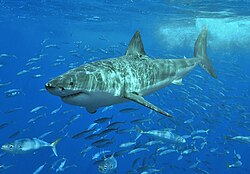Cartilaginous fish
| Cartilaginous fishes Temporal range: 422–0 Ma Latest Silurian to Present |
|
|---|---|
 |
|
| Great white shark, Carcharodon carcharias | |
| Scientific classification | |
| Kingdom: | Animalia |
| Phylum: | Chordata |
| Subphylum: | Vertebrata |
| Infraphylum: | Gnathostomata |
| Clade: | Eugnathostomata |
| Class: |
Chondrichthyes Huxley, 1880 |
| Subclasses | |
|
|
|
|
|
Chondrichthyes (/kɒnˈdrɪkθᵻ.iːz/; from Greek χονδρ- chondr- 'cartilage', ἰχθύς ichthys 'fish') is a class that contains the cartilaginous fishes: they are jawed vertebrates with paired fins, paired nares, scales, a heart with its chambers in series, and skeletons made of cartilage rather than bone. The class is divided into two subclasses: Elasmobranchii (sharks, rays, skates, and sawfish) and Holocephali (chimaeras, sometimes called ghost sharks, which are sometimes separated into their own class).
Within the infraphylum Gnathostomata, cartilaginous fishes are distinct from all other jawed vertebrates.
The skeleton is cartilaginous. The , which is present in the young, is gradually replaced by cartilage. Chondrichthyans also lack ribs, so if they leave water, the larger species' own body weight would crush their internal organs long before they would suffocate.
As they do not have bone marrow, red blood cells are produced in the spleen and the epigonal organ (special tissue around the gonads, which is also thought to play a role in the immune system). They are also produced in the Leydig's organ, which is only found in certain cartilaginous fishes. The subclass Holocephali, which is a very specialized group, lacks both the Leydig's and epigonal organs.
...
Wikipedia
